Grand Stade d'Agadir (Stade Adrar)
| Capacity | 45 480 |
|---|---|
| Country | Morocco |
| City | Agadir |
| Clubs | Hassania Union Sport d'Agadir |
| Inauguration | 11/10/2013 (Hassania – Jeunesse Kabylie, 1–0) |
| Construction | 04/06/2004 – 2013 |
| Cost | MAD 860 million |
| Design | Sâd Benkirane, Gregotti Associati International |
| Address | Rue du Grand Stade, 80000 Agadir, Morocco |
Advertisement
Stade Adrar – stadium description
The competition for design of a new major stadium in Agadir was launched back in the twentieth century, when Morocco was bidding to become the first ever African host of the FIFA World Cup. Already then the Italian-Moroccan consortium of Gregotti and Benkirane were awarded the job.
That same design, though upgraded, was submitted as Morocco’s bid for the 2010 World Cup, having failed for the 2006 edition. To increase Morocco’s chances ground clearing began in 2003. That may have been enough to win some votes and get Morocco to the final vote, but in May 2004 FIFA chose South Africa over Morocco by 14 votes to 10. This effectively ruined the Maghreb country’s chances for at least two decades as continental rotation of the World Cup was dropped soon after (in 2007) and bringing it back to Africa became a dim prospect.
Despite all that construction was officially launched just weeks after FIFA’s decision, in June 2004. But, as the stadium was no longer a priority, financing didn’t last for long and it came to a halt until 2007, when it was initially expected to open. Restarted in 2007, by 2009 the build was nearing completion when it was stopped again. It wasn’t until Morocco was granted the hosting of 2013 Club World Cup that the project was back on track. It ended up with a budget of 860 million dirhams (roughly €80m / $90m).
This proved to be a very modest sum for 45,000 seats and it was achieved mostly due to minimalized construction cost. Part of the stadium is sunken and the land excavated to hold the bowl was used to form embankments. However, this dated method didn’t mean compromising crowd circulation or amenities demanded by FIFA for spectators. Shaded routes encircle the ground, while the cheaper method proved a fine option in terms of seismic resistance, very important in an active place like Agadir.
Aesthetically the stadium seems very well fitted for its location. In fact, architects wanted it to mimic the surrounding hills. Thus the shape and natural colouring seen outside. Interestingly, the sloped elevations weren’t left as bare ground embankments, but instead are cladded with stone.
Popular club Hassania are nominal hosts of the stadium, but already on opening day it was confirmed this would be an international venue as it hosted the Morocco – South Africa friendly. Soon afterwards the first international event took place: key matches of the FIFA Club World Cup.
Advertisement
Pictures
-
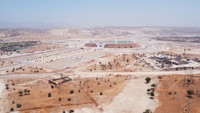
2025 © Abdou sky 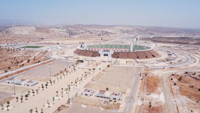
2025 © Abdou sky 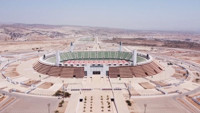
2025 © Abdou sky 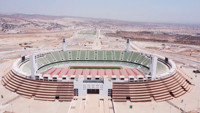
2025 © Abdou sky 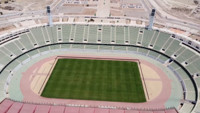
2025 © Abdou sky 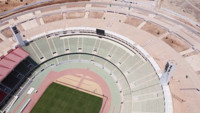
2025 © Abdou sky 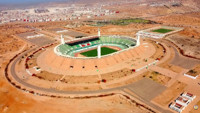
2023 © MACHARIE-ALMAGHRIB 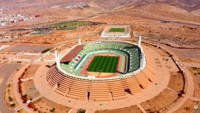
2023 © MACHARIE-ALMAGHRIB 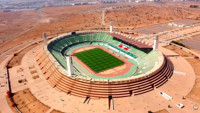
2023 © MACHARIE-ALMAGHRIB 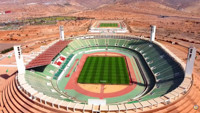
2023 © MACHARIE-ALMAGHRIB 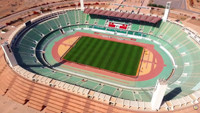
2023 © MACHARIE-ALMAGHRIB 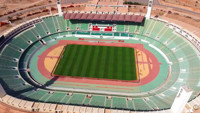
2023 © MACHARIE-ALMAGHRIB 
07.03.2015 © Groundhopping Merseburg 
07.03.2015 © Groundhopping Merseburg 
07.03.2015 © Groundhopping Merseburg 
07.03.2015 © Groundhopping Merseburg 
07.03.2015 © Groundhopping Merseburg 
07.03.2015 © Groundhopping Merseburg 
07.03.2015 © Groundhopping Merseburg 
07.03.2015 © Groundhopping Merseburg
Related news
2024
2023
-

World Cup 2030: The list of venues that will host the tournament is clarifying
2030 FIFA World Cup will enter a higher level. After the event was played four years earlier on the territory of three different countries, the world football authorities have decided to organize the competition on three separate continents. Which venues will be on the list of host cities?
-

AFCON 2025: The race to host the tournament is picking up steam
After Guinea was stripped of its rights to host the AFCON in 2025, the African Football Confederation (CAF) had to restart procedures to select a host. As many as seven countries declared official interest in hosting the event. On December 16, the nations submitted their final bid.

 StadiumDB
StadiumDB

